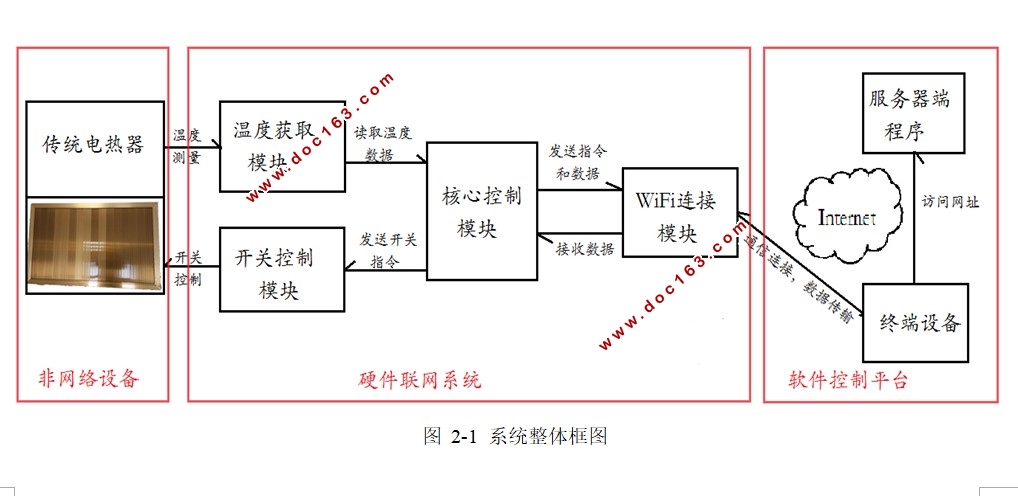基于WiFi和Web控制的智能家居的设计

基于WiFi和Web控制的智能家居的设计(论文12000字)
摘要:智能家居——将来的家庭生活的模式,开发的前景好而且商业价值很高。早在上世纪70年代,美国就已经出现这一概念。随着时代的发展和科技的进步,智能家居已经从当初的一个概念逐渐演变成一套较完善的系统理论,并且在实际技术上也有突飞猛进地发展。
现在的智能家居还是处在发展智能家电单品的阶段,在此背景下,本文通过研究智能家电的现状以及国内外的发展状况,从马克思辩证唯物主义的角度出发,深入分析了国内的实际需求,以及对现有技术的合理应用,提出并研究了将WiFi技术与Web网页开发技术相结合,开发出一套控制一款普通家用电热器的系统。
近年来WiFi技术在国内得到良好的发展和广泛的普及,可以说很多人的生活,尤其是年轻人已经离不开WiFi,这一点从各个商铺,无论大小、品种都通过WiFi来拉拢客户也不难看出。此外,web开发技术也因其良好的跨平台性而被广泛运用。
本次毕业设计在对所要实现的功能进行了合理的安排后,针对所要实现的功能设计了相应的硬件电路以及选择了合理的电子器件:选用MSP430单片机实现对整个逻辑电路的操控、选用ESP8266WiFi模块来实现单片机与客户端之间的数据传输,对电热器加热温度则是有DS18B20温度传感器来实现,最后在电路中加入继电器模块来控制电热器的开关。本设计的软件部分没有使用常用的Android软件开发,而是选择Web网页开发,实现用户登录页面和控制页面。
[来源:http://www.doc163.com]
关键字:智能家居;WiFi;Web;
[来源:http://www.doc163.com]
The design and implementation of smart home based on WiFi and Web control
Abstract:Smart home - the future of household model, has good development prospects and commercial value.In the early 1970 s, the United States has been the concept.With the development of The Times and the progress of science and technology, smart home from at the beginning of a concept gradually evolved into a more perfect system theory, and on the actual technology development by leaps and bounds.
Now, intelligent household is independent of the intelligent home appliance development stage of the item in this background, this article through studies the present situation of the intelligent home appliance and development situation at home and abroad, from the perspective of marxist dialectical materialism, deeply analyzes the actual domestic demand, and the reasonable application of existing technology, put forward and studied the wi-fi technology combined with Web page development technology, developed a set of control an ordinary household electric heater system. [资料来源:http://doc163.com]
WiFi technology in recent years at home get good development and wide spread, can say a lot of people's life, especially young people have not WiFi, it from all shops, no matter size, varieties through WiFi to woo customers also it is not hard to see.In addition, the web development technology is widely used for its good cross-platform.
In this paper to design in order to realize the function of reasonable arrangement, the corresponding hardware circuit for its functional design and choose the reasonable electronics: choose MSP430 singlechip microcomputer control of the whole logic circuit, selection ESP8266WiFi module realizes the electric heater and client remote connection and interaction, using DS18B20 temperature sensor of the electric heater heating temperature monitoring, in addition the switch of the electric heater is done by relay module.The design of the software part without use of the Android software development, but choose Web page development, realize the user login page and control.
[版权所有:http://DOC163.com]
Key words:Smart home;WiFi;Web;
[资料来源:http://doc163.com]

目 录
中文摘要 ......................................................................................................Ⅰ
英文摘要.......................................................................................................Ⅱ
1. 绪论..........................................................................................................1
1.1 国内外研究背景......................................................................................................................1
1.1.1 智能家居在国外的发展...............................................................................................1
1.1.2 智能家居在国内的发展.............................................................................................1
1.2 课题研究目的和意义..............................................................................................................2 [版权所有:http://DOC163.com]
1.3 文章组织结构阐述..................................................................................................................2
2. 系统整体分析与设计................................................................................3
2.1主要技术的比较与选择........................................................................................................3
2.1.1传输技术的选择 ..........................................................................................................3
2.1.2软件平台的选择............................................................................................................3
2.2整体系统设计...........................................................................................................................4
3. 硬件系统设计............................................................................................5
3.1 硬件电路整体设计.................................................................................................................5 [来源:http://www.doc163.com]
3.2 各功能模块的实现.................................................................................................................5
3.2.1 MSP430系列单片机 ..................................................................................................5
3.2.2 ESP8266 WiFi模块 ....................................................................................................6
3.2.3 DS18B20温度传感器..................................................................................................8
3.2.4继电器模块..................................................................................................................10
3.3总结.........................................................................................................................................12
4. 软件系统实现..........................................................................................13
4.1软件系统流程.........................................................................................................................13
[来源:http://Doc163.com]
4.2单片机程序设计.....................................................................................................................13
4.2.1 ESP8266初始化..........................................................................................................13
4.2.2 DS18B20初始化.........................................................................................................14
4.2.3开关控制程序..............................................................................................................15
4.2.4温度读取程序..............................................................................................................15
4.3终端程序设计.........................................................................................................................16
4.3.1登陆和注册页面的实现 ............................................................................................16
4.3.2 Socekt通信实现 ........................................................................................................17
4.3.3开关控制的实现..........................................................................................................18
4.3.4加热温度显示..............................................................................................................18
4.4总结.......................................................................................................................................18
5. 测试与结果分析......................................................................................19
5.1仿真测试 .............................................................................................................................19
5.2结果分析................................................................................................................................22
6. 结束语......................................................................................................24
……
参考文献.......................................................................................................25 [版权所有:http://DOC163.com]
致谢...............................................................................................................27 [版权所有:http://DOC163.com]
